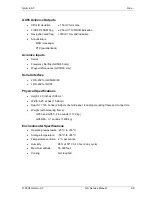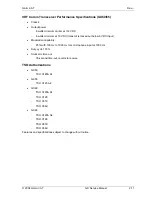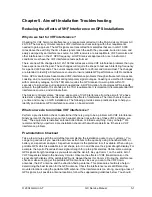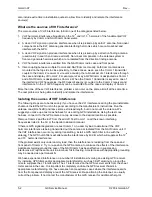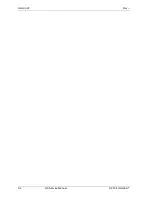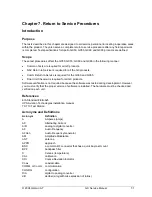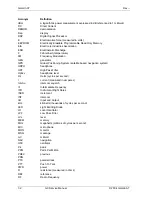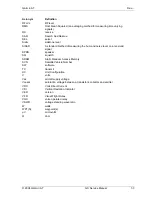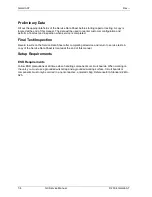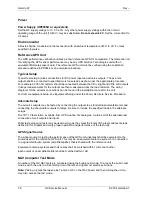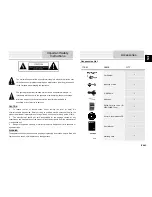
© 2004 Garmin AT
GX Service Manual
5-1
Chapter 5. Aircraft Installation Troubleshooting
Reducing the effects of VHF Interference on GPS Installations
Why do we test for VHF interference?
Checking for VHF harmonic interference is a requirement called out in the FAA Advisory Circular AC
20-138. The Advisory Circular requires VHF interference checks along with other requirements
needed to gain approval. The GPS signals are transmitted from satellites that are in orbit 10,000
miles above the earth. By the time these signals reach the earth they are weak, buried in noise, and
easily swamped by an interference source. As GPS receivers are susceptible to VHF harmonics and
other interference on the L1 GPS frequency, all GPS receivers approved for use in instrument
conditions must have the VHF interference tests performed.
There are new FAA changes to AC 20-138 that will expose more VHF interference problems than you
have experienced in the past. These changes will require the shops to test each interfering frequency
for a period of 45 seconds. The current requirement calls for a 20-second transmit test. The changes
are intended to identify all interference sources to insure reliable GPS performance in IFR conditions.
Some GPS manufactures have masked VHF interference problems through software techniques like
coasting, and not warning the pilot during temporary signal outages. Coasting is a method for dealing
with momentary outages, but the TSO also requires the GPS receiver to warn pilots within 10
seconds of a signal loss during approach operations. All UPS Aviation Technologies GPS products
will warn the pilot within 10 seconds per the TSO requirements. It is important to isolate potential VHF
interference sources, and eliminate them.
The Advisory Circular states, “Remove any source of VHF interference from the aircraft.” We have
listed some steps that can be taken to reduce the effects of interference. The intent here is to save
you time and money on GPS installations. The following provides some practical steps to help you
identify and minimize GPS interference sources on board aircraft.
What can we do to minimize VHF interference?
Perform a pre-installation check to determine if there is going to be a problem with VHF interference.
Ninety percent of the time when our tech support phone rings with one of these VHF problems, we
hear, “The equipment is installed, antenna bolted down. I’ve tried everything. Can you help?” We
recommend that you perform a pre-installation checkout that will help determine if there is a VHF
interference problem.
Pre-Installation Checkout
Take a few minutes with the aircraft before completing the installation quote to your customer. You
can get a good idea if you need to add a few extra hours to the quote by using a handheld GPS, or,
better yet, a spectrum analyzer. A spectrum analyzer is the preferred tool, if available. When using a
portable GPS, which is available to most shops, turn it on and observe the signal strength display. For
example, the Apollo Precedus shows signal strength for up to eight satellites. Obtain some average
GPS signal strength readings as you walk around the aircraft. Key up Comm 1 on the entire list of
VHF frequencies listed in the Advisory Circular. Observe the effects of VHF transmissions on the
signal strength display of the portable GPS unit. Repeat the test for Comm 2. During the interference
checks, make sure you get the portable GPS antenna as close as you can to the VHF Comm
antennas, the ELT antenna, and the direction-finding antenna. This procedure should also help in
determining the best location for the GPS antenna. Check the interference levels at different top-
mounted locations using the portable GPS antenna. If the interference is too strong, causing a loss of
GPS signals in all possible antenna locations, follow the suppression guidelines below. You should
Summary of Contents for APOLLO GX SERIES
Page 8: ...Garmin AT Rev viii GX Service Manual 2004 Garmin AT This Page Intentionally Left Blank...
Page 12: ...Garmin AT Rev 1 4 GX Service Manual 2004 Garmin AT...
Page 24: ...Garmin AT Rev 2 12 GX Service Manual 2004 Garmin AT...
Page 26: ...Garmin AT Rev 3 2 GX Service Manual 2004 Garmin AT...
Page 27: ...2004 Garmin AT GX Service Manual 4 1 Chapter 4 Antenna Installation Guides...
Page 28: ...Garmin AT Rev 4 2 GX Service Manual 2004 Garmin AT...
Page 32: ...Garmin AT Rev 5 4 GX Service Manual 2004 Garmin AT...
Page 96: ...Garmin AT Rev 7 58 GX Service Manual 2004 Garmin AT...
Page 98: ...Garmin AT Rev 8 2 GX Service Manual 2004 Garmin AT Figure 8 1 GX55 Assembly Board Locations...
Page 122: ...Garmin AT Rev 8 26 GX Service Manual 2004 Garmin AT...
Page 130: ...Garmin AT Rev 9 8 GX Service Manual 2004 Garmin AT...
Page 140: ...Garmin AT Rev 10 10 GX Service Manual 2004 Garmin AT Figure 10 5 Comm Board Block Diagram...
Page 152: ...Garmin AT Rev 10 22 GX Service Manual 2004 Garmin AT...
Page 158: ...Garmin AT Rev 11 6 GX Service Manual 2004 Garmin AT...
Page 160: ...Garmin AT Rev 12 2 GX Service Manual 2004 Garmin AT...
Page 162: ...Garmin AT Rev 13 2 GX Service Manual 2004 Garmin AT...
Page 165: ......
Page 166: ......







